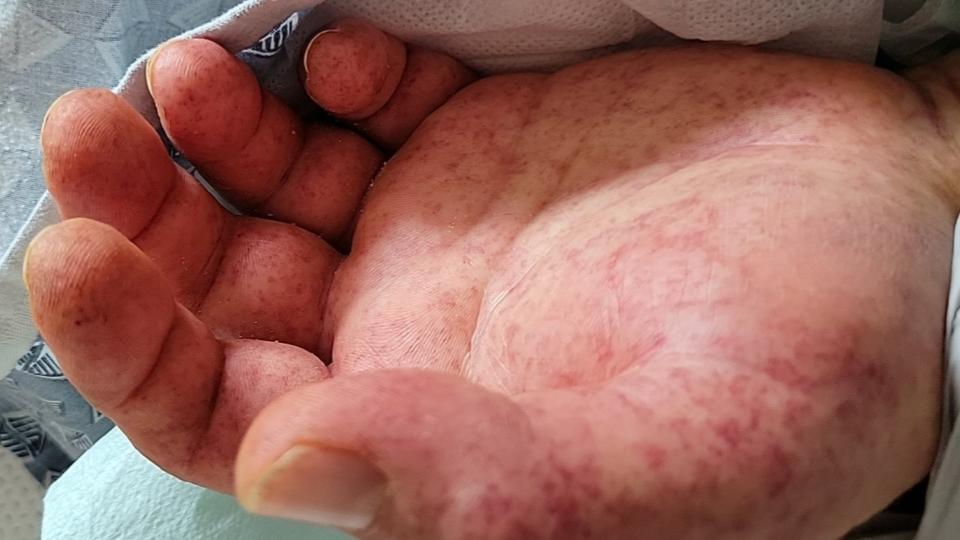Case Presentation: A 61 year old male with a past medical history of hypertension, hyperlipidemia, and obstructive sleep apnea presented to the hospital with fever. He reported 1 week of fever to 103 F with associated rigors, abdominal pain, confusion, and decreased urine output. He reported a keen interest in outdoor activities such as hiking. On exam, he was noted to have diffuse, non-blanching petechial rash involving the palms and soles. Labs were notable for hyponatremia to 132 meq/L, AKI with creatinine of 2.41 mg/dl, transaminitis with AST 530/ALT 184 IU/L, leukocytosis to 12.4 K/uL, and thrombocytopenia with platelets of 45 x K/uL. Imaging was notable for mild splenomegaly. Hospital course was complicated by respiratory compromise requiring intubation and ICU transfer, shock, worsening AKI, as well as seizure. Given his thrombocytopenia, hemophagocytic lymphohistiocytosis (HLH) was suspected. Ferritin and triglycerides were checked and were elevated at 9,341 ng/mL and 904 mg/dL, respectively. The patient underwent a bone marrow biopsy which confirmed hemophagocytosis. Extensive infectious work-up revealed positive IgG and IgM antibodies to Rocky Mountain Spotted Fever (RMSF). Patient was diagnosed with secondary HLH due to RMSF infection. He was treated with a course of doxycycline for RMSF as well as dexamethasone for HLH with subsequent control of immune system overactivation and improvement in his multiorgan dysfunction.
Discussion: RMSF is a rapidly progressive disease that can be fatal within days without early recognition and treatment. Rickettsial infection leads to direct vascular injury and increased vascular permeability by promoting endothelial cell prostaglandin production. This can lead to various complications such as interstitial pneumonitis, encephalitis, and myocarditis. Symptoms of RMSF include fever, petechial rash involving the palms and soles, and headache. Later illness can progress to altered mental status, respiratory compromise, and multiorgan system dysfunction. Common lab findings include thrombocytopenia, transaminitis, leukocytosis, and hyponatremia. Doxycycline is the treatment of choice for RMSF.HLH is a syndrome of excessive immune overactivation. Secondary HLH can result from an underlying immunologic trigger, most commonly infectious, malignant, or rheumatologic. Typical findings include fever, hepatosplenomegaly, cytopenias, elevated ferritin, and hemophagocytosis seen on tissue biopsy. Treatment of secondary HLH is directed at the underlying trigger, however in cases of clinical deterioration treatment using the HLH-94 protocol with dexamethasone and etoposide is recommended. For our patient, treatment of the underlying infection as well as dexamethasone alone were able to control his immune system overactivation. Rickettsial infections are known to cause secondary HLH, however despite being the most common rickettsial infection very few published reports of HLH secondary to RMSF have been reported aside from two studies describing RMSF associated HLH on postmortem cases.
Conclusions: We present a rare case of RMSF leading to secondary HLH, both potentially fatal diagnoses for which early recognition and management are key.

